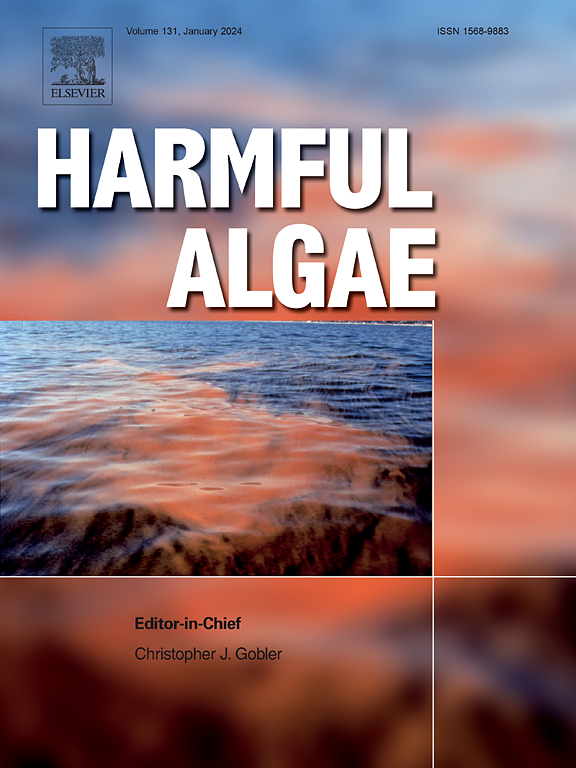Long-term spatiotemporal variability and regime classification of Chlorophyll-a concentrations in Lake Erie using satellite products
IF 4.5
1区 生物学
Q1 MARINE & FRESHWATER BIOLOGY
引用次数: 0
Abstract
Monitoring chlorophyll-a (Chl-a) concentrations in Lake Erie is crucial for managing harmful algal blooms (HABs) that pose risks to water quality and public health. While in-situ Chl-a monitoring continues, its ability to capture the overall Chl-a patterns across the lake is limited by local heterogeneity. Satellite products address this limitation by providing broader spatiotemporal coverage, overcoming the constraints of point-based measurements. Among the nine satellite products evaluated, MODIS-Terra was selected as the optimal choice due to its strong correlation with in-situ measurements (ρ = 0.71) and extensive long-term data availability (60.08 % pixel availability on valid dates). Using MODIS-Terra data, we analyzed the long-term spatiotemporal Chl-a dynamics in Lake Erie over a 24-year period (2000–2023). Composite patterns, derived by averaging 24 years of data for each location, revealed higher Chl-a concentrations in western Lake Erie and along the shorelines, with a decline towards the center of the lake. Chl-a concentration typically peaked in August or September during the HABs-prone period from June to October, with the timing varying by location. Furthermore, long-term trends at each location, assessed using the Mann-Kendall test, indicated an increasing trend in 34.43 % of the lake area and no trend in 65.51 %. The areas with increasing trends were primarily concentrated in the central and western regions of Lake Erie. Based on Chl-a levels and trends, we identified and classified nine Chl-a regimes across the lake. Each regime is characterized by distinct Chl-a levels and varied long-term trends, which differ from those observed in-situ measurements and from the average patterns seen across the entire lake. These findings provide a comprehensive understanding of the long-term spatiotemporal dynamics of Chl-a in Lake Erie, while emphasizing local Chl-a heterogeneity. Moreover, the long-term Chl-a analysis and regime classification can guide decision-making, supporting the prioritization of Chl-a management areas and the expansion of monitoring networks.

基于卫星产品的伊利湖叶绿素a浓度的长期时空变异性和状态分类
监测伊利湖的叶绿素-a (Chl-a)浓度对于管理对水质和公众健康构成威胁的有害藻华(HABs)至关重要。虽然原位Chl-a监测仍在继续,但其捕捉湖泊整体Chl-a模式的能力受到局部异质性的限制。卫星产品通过提供更广泛的时空覆盖,克服了基于点的测量的限制,解决了这一限制。在评估的9个卫星产品中,MODIS-Terra被选为最佳选择,因为它与原位测量具有很强的相关性(ρ = 0.71),并且具有广泛的长期数据可用性(有效日期的像元可用性为60.08%)。利用MODIS-Terra数据,分析了2000-2023年24 a期间伊利湖Chl-a的长期时空动态。通过对每个地点24年的数据进行平均得出的复合模式显示,伊利湖西部和沿岸地区的Chl-a浓度较高,向湖中心方向下降。6 - 10月赤潮易发期的8 - 9月,Chl-a浓度达到峰值,随地点的不同而不同。此外,利用Mann-Kendall检验评估各地点的长期趋势,34.43%的湖泊面积有增加趋势,65.51%的湖泊面积没有趋势。呈上升趋势的地区主要集中在伊利湖中部和西部。基于Chl-a的水平和趋势,我们确定并分类了整个湖泊的9个Chl-a区。每种状态的特征是不同的Chl-a水平和不同的长期趋势,不同于原位观测和整个湖泊的平均模式。这些发现为全面了解伊利湖Chl-a的长期时空动态提供了依据,同时强调了Chl-a的局地异质性。此外,长期的Chl-a分析和制度分类可以指导决策,支持Chl-a管理领域的优先排序和监测网络的扩展。
本文章由计算机程序翻译,如有差异,请以英文原文为准。
求助全文
约1分钟内获得全文
求助全文
来源期刊

Harmful Algae
生物-海洋与淡水生物学
CiteScore
12.50
自引率
15.20%
发文量
122
审稿时长
7.5 months
期刊介绍:
This journal provides a forum to promote knowledge of harmful microalgae and macroalgae, including cyanobacteria, as well as monitoring, management and control of these organisms.
 求助内容:
求助内容: 应助结果提醒方式:
应助结果提醒方式:


